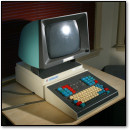August 21st, 2015 by Benj Edwards

Nintendo released the Virtual Boy 20 years ago today in North America (on August 21, 1995). I wrote an article about the creation of the Virtual Boy for FastCompany, which was just published today.
I hope you enjoy it.
Posted in Gaming History, News & Current Events, Retrogaming | 6 Comments »
Tags: 1995, anniversaries, FastCompany, freelance work, Nintendo, Virtual Boy
August 17th, 2015 by Benj Edwards
 How Video Games Are Designed
How Video Games Are Designed
[ From VG&CE, November 1992, p.59]
Discussion Topic of the Week: What’s your favorite Tetris spin-off game?
Posted in Gaming History, Regular Features, Retro Scan of the Week, Retrogaming | 5 Comments »
Tags: 1992, advertisement, Game Boy, Nintendo, puzzle games, Retro Scan, Spectrum HoloByte, Super NES, Tetris, VGCE, Wordtris
August 10th, 2015 by Benj Edwards
 When taking apart your PC was required
When taking apart your PC was required
I recently inherited a SWTPC 6800 and a fair number of accessories and peripheral cards from a late friend of my father’s. The 6800 was one of the first personal computers, released in 1975, which makes my unit the oldest computer in my collection. The SWTPC 6800 takes its name from its CPU, the Motorola 6800, which was one of the earliest microprocessors, and it refreshingly utilizes a non-S-100 bus. In fact, it created its own minor bus standard called SS-50 that manufacturers like Smoke Signal Broadcasting incorporated into compatible machines.
The 6800 is really neat machine — I cleaned up all the boards, but I can’t get it to boot so far. I’ll have to give it a shot again at a later date.
[ From BYTE Magazine, March 1977, inside front cover]
Discussion Topic of the Week: Do you own any computer released prior to 1977? Tell us about it.
Posted in Computer History, Regular Features, Retro Scan of the Week, Vintage Computing | 6 Comments »
Tags: 1975, 1977, advertisement, Altair, BYTE, Motorola, Motorola 6800, Otto, Retro Scan, S-100, Smoke Signal Broadcasting, SS-50, SWTPC, SWTPC 6800
August 3rd, 2015 by Benj Edwards
 The 4-inch Michael Jordan
The 4-inch Michael Jordan
I remember seeing a playable demo of Air Zonk in my local Toys ‘R’ Us around the time it came out (probably early 1993). I remember it being marketed as a pack-in for the TurboDuo. Upon playing the demo, my first thought was along the lines of: “Wow, the TurboGrafx-16 is still around? They must be desperate.”
(For those of you who don’t know, my brother and I took the TG-16 plunge circa 1990 or 1991.)
By 1993, the SNES and Genesis were in full force — I owned a SNES and enjoyed it quite a bit. I was deep into Street Fighter II fever at that point. I drooled over the TurboDuo when it came out, though, and I always had a soft spot for the TG-16.
My second about Air Zonk was, “Hmm, this game isn’t very good.” So I released the controller and didn’t play it again until perhaps 20 years later on an emulator. I still don’t like it very much.
[ From VG&CE, November 1992, p.46]
Discussion Topic of the Week: Which do you like better: Air Zonk or Bonk’s Adventure?
Posted in Gaming History, Regular Features, Retro Scan of the Week, Retrogaming | 1 Comment »
Tags: 1992, advertisement, Air Zonk, Bonk, Hudson Soft, NEC, Retro Scan, TTI, TurboDuo, TurboGrafx-16, VGCE
July 27th, 2015 by Benj Edwards
 NOW AVAILABLE IN RUST
NOW AVAILABLE IN RUST
The Vector 1 (1977) was the first complete computer system sold by Vector Graphic, Inc., a California-based firm founded by Lore Harp (now McGovern), Carole Ely, and Bob Harp in August 1976.
The Vector 1 included an Intel 8080A or Zilog Z80 CPU, and it utilized the S-100 bus introduced by the Altair 8800. In an unusual nod to aesthetics, the Vector 1 shipped in two case color options: green or “rust,” which was Vector’s name for orange. It retailed for for $849 fully assembled (about $3,288 today when adjusted for inflation) or $619 as a kit.
It just so happens that I wrote an article about the history of Vector Graphic for FastCompany recently. You may enjoy it.
[ From Byte Magazine, February 1977, p.61]
Discussion Topic of the Week: Have you ever owned an S-100 based computer? Tell us about it.
Posted in Computer History, Regular Features, Retro Scan of the Week, Vintage Computing | 7 Comments »
Tags: 1977, 8080, advertisement, Altair 8800, Bob Harp, BYTE, Carole Ely, CPU, FastCompany, freelance work, Intel, Lore Harp, Retro Scan, S-100, Vector 1, Vector Graphic, Z80, Zilog
July 20th, 2015 by Benj Edwards
 “100% Rendered Black Void” — I like the humor in this ad
“100% Rendered Black Void” — I like the humor in this ad
In the mid-1990s, much to my delight, game publishers began remaking and re-releasing classic games of the 1970s and 1980s in collections on Mac, PC, and consoles. You remember — I’m talking about titles such as Microsoft Arcade (1993), Atari 2600 Action Pack (1995), the Namco Museum series (1995-1998), Arcade Classic No. 1: Asteroids / Missile Command (1995), Williams Arcade’s Greatest Hits (1996). Even Super Mario All-Stars (1993) counts to some extent.
That happened to be around the same time I started collecting old video game and computer systems, roughly in 1993, so I was happy that the industry seemed to be rediscovering these “forgotten” classics.
The awkwardly titled Bubble Bubble Also Featuring Rainbow Islands falls into the same category, being a re-release of the arcade version of Bubble Bobble and its sequel Rainbow Islands on PlayStation 1 and MS-DOS.
[ From GamePro, October 1996, p.5]
Discussion Topic of the Week: In your opinion, what are some of the best executed game retro remakes and re-releases?
Posted in Computer Games, Gaming History, Regular Features, Retro Scan of the Week, Retrogaming | 4 Comments »
Tags: 1996, advertisement, arcade, Bubble Bobble, GamePro, MS-DOS, PlayStation, PS/1, Rainbow Islands, re-release, Retro Scan, Sony, Taito
July 13th, 2015 by Benj Edwards
 I’m not sure I’m ready to take such a big step, APF.
I’m not sure I’m ready to take such a big step, APF.
I once did a slideshow of game console-to-computer upgrades, and the APF Imagination Machine figured prominently in the list. That’s because it was a combination of the APF-M1000 home video game system and the “IM-1,” which was a large keyboard/speaker dock with a built-in cassette tape player (for program storage and retrieval).
What an odd machine. To my knowledge, the M1000 was the only video game system based on the Motorola 6800 CPU, which is one of the grand-daddies in the microprocessor world (first released in 1974).
While neither the console nor the computer fared well commercially, this distinctive advertisement leaves a positive impression. It was brilliantly playful and colorful for a computer ad of the time (1979; this particular scan of the ad comes from 1980).
[ From BYTE Magazine, July 1980, p.43]
Discussion Topic of the Week: Best console add-on of all time?
Posted in Computer History, Gaming History, Regular Features, Retro Scan of the Week, Retrogaming, Vintage Computing | 4 Comments »
Tags: 1980, advertisement, APF, APF-M1000, BYTE, console expansions, Imagination Machine, Retro Scan
July 13th, 2015 by Benj Edwards
 In Memoriam: Satoru Iwata (1959-2015), President, Nintendo of Japan
In Memoriam: Satoru Iwata (1959-2015), President, Nintendo of Japan
CEO, Nintendo of America
What a horrible thing. Iwata will be sorely missed.
These days, few large company CEOs rise up through engineering (in this case, software engineering) to take the top spot at the firm. Iwata did exactly that, and that likely contributed a great deal to his success at leading Nintendo.
Nintendo needs a new rudder now. Who they choose to replace Iwata will make or break the company at this point — Nintendo is in a fragile position, poised at the edge of a transition to a new console business model designed to ensure its survival in a mobile/tablet/smartphone dominated world.
What will happen next is anybody’s guess.
What happened under Iwata was amazing.
Posted in Gaming History, Memorials, NES / Famicom, News & Current Events, Regular Features, Retrogaming | 4 Comments »
Tags: CEO, Memorials, Nintendo, President, Satoru Iwata
July 6th, 2015 by Benj Edwards
 Few people know this, but that’s actually strawberry jelly
Few people know this, but that’s actually strawberry jelly
[ From ST Log, December 1988, back cover]
Discussion Topic of the Week: What’s the best Atari ST-exclusive game you can think of?
Posted in Computer Games, Computer History, Gaming History, Regular Features, Retro Scan of the Week, Retrogaming, Vintage Computing | 1 Comment »
Tags: 1988, advertisement, Atari, Atari ST, Omnitrend Software, Paladin, Retro Scan, ST Log
June 29th, 2015 by Benj Edwards
 The IBM Instruments Computer System
The IBM Instruments Computer System
What a strange machine. The IBM Instruments Comptuer System was a completely modular 68000-based PC with its own custom OS (CSOS, according to Wikipedia, which stood for “Computer System Operating System” — ???). It also utilized Motorola’s rarely-seen Versabus bus architecture. The ICS was aimed at scientific and engineering use, and it launched in 1982 — the year following the launch of the IBM PC 5150.
Has anyone used or seen one of these? This is an oddity of oddities. Thank goodness the IBM PC didn’t end up like this.
[ From BYTE Magazine, February 1983, p.116-117]
Discussion Topic of the Week: What was the first IBM brand computer you ever owned (even when collecting)?
Posted in Computer History, Regular Features, Retro Scan of the Week, Vintage Computing | 6 Comments »
Tags: 1983, advertisement, BYTE, IBM, Instruments Computer System, modular, Retro Scan, scientific, System 9000















